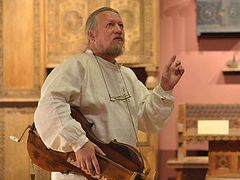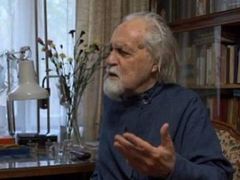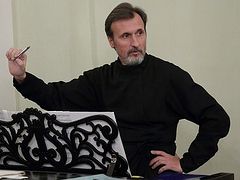—There are two traditions of Znamenny chant: naonnoye (or razdelnorechnoye) and narechnoye. What chants in this tradition are not sung in the other and why?
—Yes, since the seventeenth century the Russians have not had a unified Znamenny tradition—it was divided into two large branches: narechnoye and naonnoye singing. In turn, their local versions show some independence. Narechnoye singing, as a rule, is with breathing by phrases, and in naonnoye singing, breathing is chain. Narechnoye singing is performed with a rather academic sound in a high tessitura, while naonnoye singing is performed in a low tessitura and virtually in a folk manner. Narechnoye singing, as a rule, is according to the obikhodny twelve-step scale, and amazingly archaic changes of the fret have remained in naonnoye singing. The drones of these traditions are very different in some essential details.
It is unlikely that there are any new texts sung by enthusiasts in the Russian Orthodox Church in the naonnoye tradition in the 2000s. I’ve never heard of any. When it comes to the Russian Orthodox Church of the Moscow Patriarchate, Edinovertsi sing in the naonnoye tradition, and they are quite conservative. Although there are Edinoverie parishes that sing narechnoye. There are two Edinoverie parishes in St. Petersburg: one sings narechnoye, the other sings naonnoye.
—How is the choice usually made?
—If historically in a particular place they sang in a certain tradition, they follow it. For example, in an Edinoverie parish in Mikhailovskaya Sloboda near Moscow, before its closure, they used to sing narechnoye. Therefore, when the parish was revived, the singing resumed in the tradition that had been there before. As for new parishes, the choice is often made depending on the views of the rector and the choir director, on what they prefer.
—In the seventeenth century naonnoye singing was criticized…
—It was a little earlier too. The fact is that Znamenny chant was formed to agree with the norms of the language, which were very different from the norms of the language of the sixteenth and the seventeenth centuries. By that time there were essentially two parallel corpuses of liturgical texts—for singing and for reading. For reading, more modern texts were used, in which a large number of vowels had already fallen out. And the chant was formed for the language when these vowels were in it. A classic example: “denese” and “dnes” (“today”); there used to be three syllables, but one was left. Of course, some people resented it. Interestingly, Protopop Avvakum was only for narechnoye singing, as was the whole Circle of God-Lovers even before the schism. A significant number of Bespopovtsi [a denomination of Russian Old Believers that profess priestless worship.—Trans.] still use naonnoye singing. The translation of narechnoye singing was carried out before Patriarch Nikon’s reforms. So, some Old Believers accepted it, and some did not.
—Some enthusiasts believe that Church singing should be only like this, and not otherwise. How do you feel about this approach?
— God forbid that someone decide to “reduce everything to a common denominator”. We are all very different. I’m not talking about those who grew up in one tradition or another, but those who came to this or that tradition as adults did it out of love. Something has resonated in their hearts in a way that they don’t want any other way. And everyone sees something very valuable and important in their tradition. So scholars studying this culture, as a rule, specialize in what they love.
—How did the Vervitsa ensemble appear?
—It appeared outside the curriculum, it is an optional course. We introduce all students of the department to ancient Russian chant in order for them to get a more comprehensive idea of the entire Russian traditional culture of singing—folklore and ancient Russian chant. For most, these are several classes of lecture courses and some patterns of ancient Russian chant in the repertoire of the choral class. But the students who are interested in this are part of our ensemble—it has existed for about five years.
We are trying to master the Pomor [the northern, Archangelsk region of Russian] naonnoye tradition. The point is not only that it has preserved the most archaic principles, but also in that this tradition does not contradict the singing mentality of our students. That is, the timbre, sound production, tessitura and some orthoepic norms are clear to them.
Basically, we have Znamenny eight tone chants in our repertoire, but there are samples of putevoy and demestvenny chants. It seems particularly valuable and joyful that we have several chants in our repertoire, which we have reconstructed on the basis of expedition recordings and the hook notation in which these chants exist among Pomor singers.
—What events in the history of the ensemble seem to be the most significant?
—Firstly, every year we take part in concerts of the “Istoki” festival of Orthodox singing traditions, and we sing not only at the opening or the closing of the festival, but also at other events. We performed at concerts of the “RE-LIGO” festival-competition. Once we were invited to Finland to visit our Orthodox friends. We also take part in academic conferences not only as performers, but also as authors of reports and articles. But still, we perform more often within the walls of our institute. We don’t have many performances—firstly, because our students are very busy, and secondly, we strive not so much for concert practice—our main joy is research.
—On August 18, 2022, your colleague Valery Smirnov, the head of the Istoki choir of the Razdelnorechny Znamenny tradition, died. What memories do you have about him?
—He was a man whose entire life was connected with the Church. He was interested in all else only to the extent that you need to eat and drink something, and only for this reason you should earn some money. He was a wonderful man who reposed so early and very unexpectedly. We were very close friends. Valery was deeply immersed in the Znamenny tradition.
At first, he tried to explain to everyone how to sing Znamenny chants correctly and well, to persuade someone, but over time wisdom and understanding came—you can show how wonderful what you are doing is, but there should be no propaganda. Valery studied the tradition, sang, initiated the publication of naonnoye singing books—it was just awesome! He once suggested that we reconstruct prophetic songs. We did it at his house and even recorded two songs in the studio. And for the last five years of his life he was in such a blissful state, not trying to convince anyone, but simply swimming in what he was interested in.




